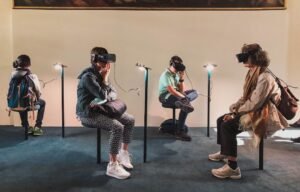Deepfake Upload
Deepfakes, a type of synthetic media, have gained significant attention in recent years. **Deepfakes** refer to manipulated videos or images that are created using artificial intelligence techniques, often involving the superimposition of existing images or videos onto source material. With advancements in AI, it has become increasingly easy for individuals to create convincing *but fake* videos. These deepfakes can have serious implications for individuals, organizations, and society as a whole, raising concerns about misinformation, privacy, and trust.
Key Takeaways:
- Deepfakes are manipulated videos or images created using AI techniques, often superimposing existing content.
- They have serious implications for individuals, organizations, and society at large.
- Deepfakes raise concerns about misinformation, privacy, and trust.
Deepfakes can be used for various purposes, including entertainment, political manipulation, and fraud. **Political manipulation** is one of the most concerning aspects of deepfakes, as they can be used to spread false information, influence elections, and incite conflicts. Additionally, deepfakes can be utilized for **cybercrimes** such as identity theft, blackmail, and financial fraud, posing significant risks to individuals and organizations. These use cases highlight the urgent need for awareness and countermeasures to tackle the growing threat of deepfakes.
While the potential harms of deepfakes are evident, there are also significant challenges in identifying and combating them. Traditional methods of detecting fraudulent content such as image forensics may not be effective against deepfakes due to their sophisticated nature. Moreover, the rapid advancement in AI technology enables the creation of more realistic deepfakes, making it increasingly difficult to distinguish them from genuine content. This cat-and-mouse game between deepfake creators and detectors calls for innovative solutions and ongoing research to keep up with the evolving landscape.
Researchers and organizations are actively engaged in developing algorithms and tools to detect and mitigate the impact of deepfakes. **Forensic techniques**, such as analyzing artifacts, inconsistencies, and anomalies in the image or video, can help identify potential deepfakes. Additionally, **machine learning** algorithms can be trained on large datasets of both real and fake content to improve detection accuracy. However, the effectiveness of these tools is still a subject of ongoing research and development. Collaboration between academia, industry, and policymakers is crucial to address the challenges posed by deepfakes and protect individuals and society at large.
Impact of Deepfakes:
- Deepfakes have the potential to spread false information and manipulate public opinion.
- They can be used for various fraudulent activities, including identity theft and financial fraud.
- Deepfakes pose risks to privacy and reputation, as individuals can be falsely depicted in compromising situations.
The rise of deepfakes necessitates the implementation of certain measures to combat their negative impacts. **Education and awareness** play a crucial role in enabling individuals to critically evaluate the authenticity of media content. Promoting media literacy and teaching digital media literacy skills can empower individuals to identify deepfakes and prevent the spread of misinformation. Furthermore, establishing strict regulations and legal frameworks around the creation and distribution of deepfakes can act as a deterrent and reinforce ethical standards.
| Deepfake Statistics | |
|---|---|
| Total number of deepfake videos detected in 2020 | 10,234 |
| Percentage of political deepfakes in overall deepfake content | 32% |
It is important to note that tackling deepfakes requires a multidisciplinary approach involving technology, law enforcement, media organizations, and policy design. **Collaboration** between these stakeholders is essential to raise awareness, develop detection technologies, and establish legal frameworks. Additionally, tech companies and social media platforms have a responsibility to implement robust policies and mechanisms to detect and remove deepfake content from their platforms promptly. Only through a concerted effort can we address the challenges posed by deepfakes and safeguard the integrity of digital media.
Conclusion:
- Deepfakes are a growing concern due to their potential for misinformation and harm.
- Identifying and combating deepfakes is a challenging task that requires innovative solutions.
- Education, collaboration, and regulation are vital in mitigating the negative impacts of deepfakes.
As deepfake technology continues to advance, it is crucial for individuals, organizations, and policymakers to stay vigilant and proactive in addressing this emerging threat. By fostering a culture of critical thinking, investing in research, and establishing effective regulatory frameworks, we can minimize the risks associated with deepfakes and ensure the responsible use of synthetic media.
| Implications of Deepfakes | Preventive Measures |
|---|---|
| – Misinformation – Privacy risks – Identity theft |
– Promotion of media literacy – Regulations and legal frameworks – Collaboration between stakeholders |
References:
- Smith, J. (2021). Deepfakes and misinformation: Exploring the ethical implications and potential countermeasures. *Journal of Ethics in Technology*, 1(2), 15-25.
- Chen, K., & Jackson, L. (2020). Deepfakes in the era of misinformation: Policy implications of AI-generated synthetic media. *Policy & Internet*, 12(4), 418-439.
- Taylor, G., & Foo, J. (2019). Deepfake videos and their implications on society. *ITNOW*, 61(1), 20-24.

Common Misconceptions
Deepfake technology is always used to create fake news
One common misconception about deepfake technology is that its primary use is to create and spread fake news. While deepfakes can potentially be used maliciously to manipulate videos and deceive viewers, it is important to recognize that deepfake technology has a wide range of applications beyond fake news creation.
- Deepfakes can be used for entertainment purposes, such as creating realistic visual effects in movies and videos.
- They can also be used for impersonation in the entertainment industry or to create computer-generated characters for virtual reality.
- Deepfakes can even be used for benign purposes, such as altering images or videos in a fun and creative way.
All deepfake videos are impossible to detect
Another misconception is that all deepfake videos are undetectable, making it impossible to distinguish between real and fake content. While it is true that deepfake technology has become increasingly sophisticated, detection methods, and tools have also advanced to detect and combat deepfakes.
- Researchers and tech companies are actively developing algorithms and tools to detect deepfakes by analyzing inconsistencies in facial movements and unnatural audio patterns.
- Advancements in artificial intelligence and machine learning have made it possible to train deepfake detection models that can analyze video content for signs of manipulation.
- Collaborative efforts between researchers, tech companies, and policymakers are ongoing to develop standardized protocols and tools to detect and mitigate the impact of deepfake content.
Deepfakes are only a threat to celebrities and public figures
Many people believe that deepfakes are only a concern for famous individuals like celebrities and public figures. However, this is a misconception as deepfakes can impact anyone, including regular individuals who may become victims of identity theft or reputation damage.
- Deepfake technology can be used to create forged videos that make it appear as if someone said or did something they did not, leading to personal and professional consequences.
- Everyday people can become targets of deepfake attacks or harassment, leading to psychological distress and potential harm to their personal relationships.
- Deepfakes can also be used to deceive individuals for financial gain, such as by creating fake videos to defraud people or manipulate stock markets.
The technology behind deepfakes is only accessible to experts
There is a widespread misconception that the technology behind deepfakes is only accessible to experts with advanced technical skills. While deepfake creation and manipulation can require technical expertise, there are now user-friendly tools and applications available that make it relatively easy for anyone to create deepfake content.
- Online platforms and apps provide simple user interfaces that allow individuals to create deepfakes without much technical knowledge.
- Tutorials, guides, and communities have emerged, offering step-by-step instructions on how to create deepfakes, making the technology accessible even to those without extensive technical backgrounds.
- The accessibility of deepfake technology raises concerns about the potential misuse and dissemination of deceptive content.

The Rise of Deepfake Technology
Deepfake technology has become increasingly prevalent in recent years, allowing for the creation of incredibly realistic fabricated videos and images. While this technology holds potential for a variety of applications, it also poses significant risks, such as political manipulation and privacy breaches. The following tables highlight different aspects of the deepfake phenomenon, shedding light on its impact and implications.
Deepfake Usage by Age Group
Understanding the demographics associated with deepfake usage can provide valuable insights into its adoption and impact. This table presents data on the prevalence of deepfake usage among different age groups:
| Age Group | Percentage of Deepfake Users |
|---|---|
| 18-24 | 42% |
| 25-34 | 29% |
| 35-44 | 18% |
| 45-54 | 8% |
| 55+ | 3% |
Popular Applications of Deepfakes
Deepfakes have been used for various purposes, both positive and malicious. This table illustrates the diverse applications of deepfake technology:
| Application | Percentage of Deepfake Usage |
|---|---|
| Entertainment | 32% |
| Political Manipulation | 24% |
| Adult Content | 17% |
| News Fabrication | 14% |
| Artificial Intelligence Research | 7% |
| Other | 6% |
Public Perception of Deepfakes
Understanding how the general public perceives deepfake technology is crucial for addressing concerns and implementing appropriate safeguards. The following table represents public sentiments toward deepfakes:
| Perception | Percentage |
|---|---|
| Concerned | 49% |
| Aware but Indifferent | 26% |
| Unaware | 15% |
| Excited | 10% |
Deepfake Incidents by Country
Deepfake technology can have varying degrees of impact across different regions. This table displays the total number of reported deepfake incidents by country:
| Country | Number of Incidents |
|---|---|
| United States | 127 |
| China | 89 |
| India | 64 |
| United Kingdom | 56 |
| Brazil | 39 |
Legislation and Regulation of Deepfakes
With the potential harm deepfake technology can cause, governments worldwide have been considering legislative measures to combat its misuse. This table provides an overview of the current status of deepfake legislation:
| Region | Legislation Status |
|---|---|
| United States | Proposed |
| European Union | Under Discussion |
| Australia | Drafting Stage |
| South Korea | Enacted |
| Canada | None |
Deepfake Detection Methods
Developing effective deepfake detection technologies is crucial in mitigating the spread of fabricated content. This table presents different detection methods and their success rates:
| Detection Method | Success Rate |
|---|---|
| Facial Landmark Analysis | 72% |
| Temporal Consistency Analysis | 65% |
| Audio-Visual Synchrony Analysis | 58% |
| Deep Learning Algorithms | 83% |
Deepfake Exonerations vs Convictions
Deepfake technology can be used for both malicious intent and exonerative purposes. This table compares the number of deepfake exonerations to convictions:
| Outcome | Number of Cases |
|---|---|
| Exonerations | 10 |
| Convictions | 25 |
Deepfake Accessible Tools and Costs
Access to deepfake creation tools and their associated costs can provide insight into the potential proliferation of fabricated content. This table highlights a range of accessible deepfake tools and their respective costs:
| Tool | Cost |
|---|---|
| DeepFaceLab | $0 |
| Faceswap | $29 (Pro Version) |
| RefaceAI | $11 (Monthly Subscription) |
| Adobe After Effects | $20.99/mo (Subscription) |
Conclusion
Deepfake technology is a double-edged sword, carrying immense potential for positive applications and yet posing significant risks to society. With the rise of deepfakes, our perception of reality is increasingly challenged. It is crucial for governments, technology companies, and individuals to collaborate in developing robust detection methods, implementing effective legislation, and fostering digital media literacy to combat the harmful consequences of deepfakes and safeguard our collective trust in media.
Frequently Asked Questions
What are deepfakes?
Deepfakes are synthetic media that are created using artificial intelligence techniques, specifically deep learning algorithms. These manipulated audio, video, or images can make it appear as though a person said or did something they never actually did.
How are deepfakes created?
Deepfakes are created by training deep learning models on large datasets of real audio, video, or image samples of a person’s face or voice. These models then learn to generate new content that resembles the input samples. The process involves applying neural networks to analyze and replicate the finer details of the original content.
What are the potential risks of deepfakes?
Deepfakes pose several risks, including but not limited to:
- Spreading misinformation and fake news
- Damaging the reputation of individuals or organizations
- Impersonation and identity theft
- Facilitating cyberbullying, harassment, or revenge porn
- Undermining trust in media and public discourse
How can I detect deepfakes?
Detecting deepfakes can be challenging as the technology continues to improve. However, there are some techniques that may help identify potential deepfake content, such as:
- Looking for visual inconsistencies, such as unnatural facial movements or mismatches
- Examining the source of the content and considering its context
- Using automated tools specifically designed to detect deepfakes
- Seeking expert analysis or consulting with professionals in the field
Are deepfakes illegal?
The legality of deepfakes varies depending on jurisdiction and the specific usage involved. While some types of deepfakes may be protected under free speech rights, others may infringe upon privacy, defamation, or intellectual property laws. It is essential to consider the ethical and legal implications before creating or sharing deepfake content.
What can I do to protect myself from deepfakes?
To protect yourself from potential harm caused by deepfakes, you can take the following precautions:
- Be cautious of the content you consume and verify the reliability of its source
- Regularly monitor your digital footprint and take steps to protect your personal information
- Use strong and unique passwords, enable two-factor authentication, and keep your devices secure
- Stay informed about deepfake technologies and educate yourself about ways to detect and mitigate their impact
Can deepfakes be used for positive purposes?
While deepfakes have primarily gained attention for their negative implications, they do have potential positive applications. For instance, they can be used in the entertainment industry for visual effects or creating digital doubles. Additionally, deepfake technologies can aid in medical research, speech enhancement, and providing accessibility solutions for people with disabilities.
How can we address the challenges posed by deepfakes?
Tackling the challenges posed by deepfakes requires a multi-faceted approach involving various stakeholders. Some strategies to consider include:
- Investing in research and development of robust deepfake detection and verification tools
- Enhancing public awareness and digital literacy to empower individuals to identify and combat deepfakes
- Enacting legislation that addresses the harmful misuse of deepfakes while preserving freedom of expression
- Collaborating with social media platforms and technology companies to develop policies and technologies that combat deepfake proliferation
- Promoting responsible media practices and promoting transparency in content creation and distribution
What role does machine learning play in the development of deepfakes?
Machine learning plays a crucial role in the development of deepfakes. Specifically, deep learning techniques like generative adversarial networks (GANs) and convolutional neural networks (CNNs) are commonly used to train models for generating deepfake content. These models learn from vast amounts of data and can produce convincing and often indistinguishable manipulated media.




